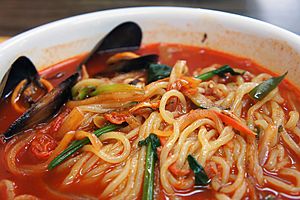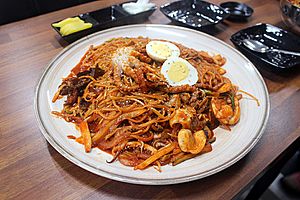Jjamppong facts for kids
 |
|
| Type | Guksu |
|---|---|
| Course | Main course |
| Place of origin | China (original) Korea (adaptation) |
| Region or state | East Asia |
| Associated national cuisine | Korean Chinese cuisine |
| Serving temperature | Hot |
| Korean name | |
| Hangul |
짬뽕
|
|---|---|
| Hanja |
攙烹
|
| Revised Romanization | jjamppong |
| McCune–Reischauer | tchamppong |
| IPA | [t͈ɕam.p͈oŋ] |
Jjamppong (Korean: 짬뽕; Hanja: 攙烹) is a super tasty and spicy Korean Chinese noodle soup! It's famous for its bright red broth, which gets its color and kick from chili powder. This yummy soup is packed with fresh seafood like squid and mussels, or sometimes pork.
You'll often find lots of vegetables in it too. These include onions, garlic, Korean zucchini, carrots, and cabbages. It's a very popular dish in South Korea.
Along with another dish called Jajangmyeon, Jjamppong is a favorite meal. You can find it mostly in Chinese restaurants across Korea.
Contents
How Jjamppong Got Its Name and History
Jjamppong has an interesting story behind its name and how it became popular. The dish originally came from a Chinese noodle soup. This soup was from the Shandong region of China.
From China to Japan to Korea
The original Chinese dish was called chǎomǎmiàn (炒码面). Later, a similar dish in Japanese Chinese cuisine was called chanpon. This Japanese dish itself came from a Chinese noodle soup from the Fujian region.
During a time when Japan had a strong influence in Korea (from 1910 to 1945), Japanese people saw chǎomǎmiàn in Chinese restaurants in Korea. They thought the white soup looked like their own chanpon soup. So, they started calling it chanpon.
The Korean people then took the Japanese word chanpon and changed it slightly to jjamppong. That's how this delicious noodle soup got its unique name!
How the Broth Changed Over Time
The way Jjamppong is made today is a bit different from its early versions. The original Chinese chǎomǎmiàn likely used boiled pork and chicken bones for its broth.
However, Korean Jjamppong changed, especially in the 1960s. Now, the broth is usually made by stir-frying seafood and vegetables first. Then, chili powder (called gochugaru) and chili oil are added. This gives Jjamppong its famous spicy, red color and rich flavor!
Different Kinds of Jjamppong
There are many fun variations of Jjamppong to try! Each one offers a slightly different taste or ingredient.
- Samsun Jjamppong (삼선짬뽕): This is a more special and often pricier version. It comes with even more kinds of delicious seafood.
- Pork Back-bone Jjamppong (뼈짬뽕): This type is inspired by a Korean stew called Gamja-tang. It uses a broth made from pork bones. It also has stir-fried seafood, chili oil, and vegetables.
- Gul Jjamppong (굴짬뽕): If you love oysters, this one is for you! It's packed with oysters and usually has a spicy white broth. Sometimes it's called Sacheon Tangmyeon.
- Gochu Jjamppong: This version is extra spicy! It uses special Cheongyang chili peppers to give it an even bigger kick.
- Pan-fried Jjamppong: Some restaurants serve a pan-fried version. It's like a stir-fry with the Jjamppong flavors, but without the soup.
- Jjamppong Bap (짬뽕밥): If you prefer rice over noodles, this is the perfect choice. It's Jjamppong served with rice instead of noodles.
See also
 In Spanish: Jjamppong para niños
In Spanish: Jjamppong para niños


